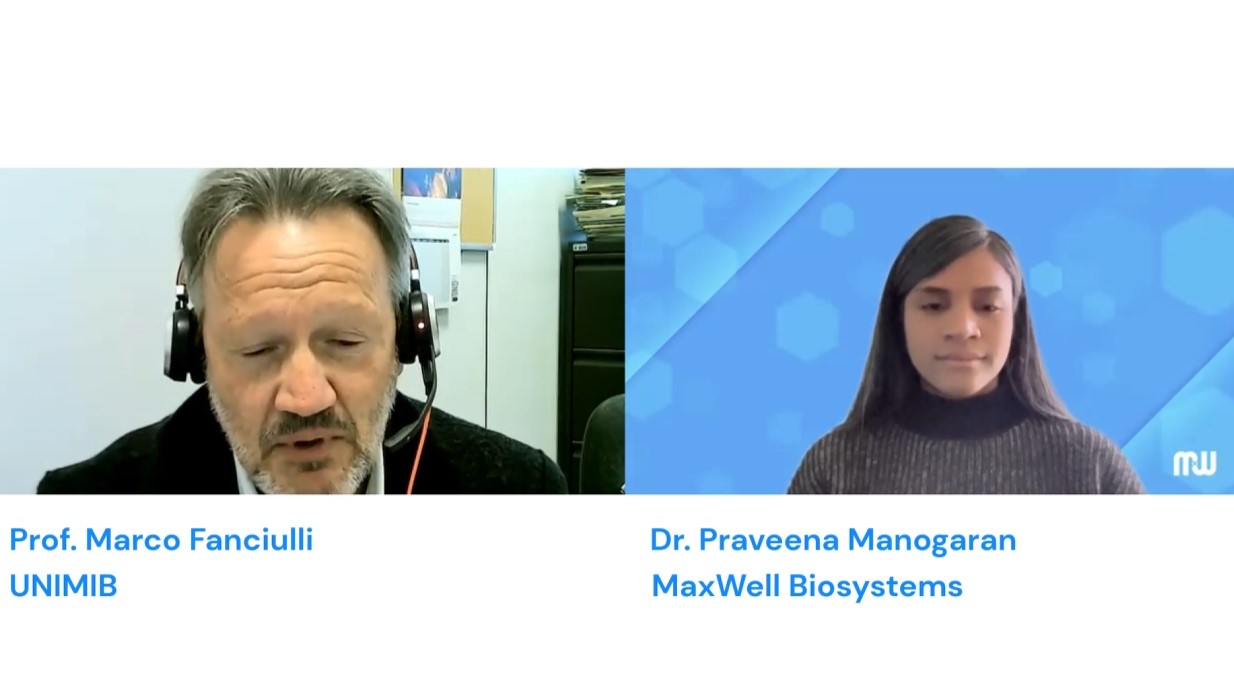This week continue our series of online NEUREKA consortium principal investigators (PI) interviews. In this video, Dr. Praveena Manogaran, Senior Scientist at MaxWell Biosystems interviews Prof. Marco Fanciulli, our NEUREKA partner at UNIMIB.
I’d like to begin the interview by asking you to give us some details on your background and expertise
I graduated in Italy in nuclear engineering and then I went to US to Boston for my PhD in Applied Physics then I spent five years in Denmark working on mainly silicon and semiconductor Technologies and science then I came back to Italy more than 20 years ago to establish a new laboratory at a government laboratory inside as micro Electronics dedicated to micro Nano electronics. Then later I got a position as a full professor at the University of Milano Biccoca in the department of Material Science and my main expertise in material science spectroscopy techniques for micro Nano electronics spintronics and also Innovative type of devices for computation and memories.
What is the main role of your lab in this NEUREKA project?
The main goal of my group is the growth by atomic layer deposition which is a technique which is providing highly conformal deposition and since we are supposed to grow on nanopillars that is absolutely mandatory for this project. Also the characterization of structure morphology physical chemical electrochemical using different methods of thin metallic and or insulating layers suitable for neuroelectronics in particular of course for the stimulation and the recording of the action potential
What are the main contributions of the NEUREKA project that will advance your specific field of research?
The project of course is allowing and is providing an opportunity to broaden the processes and the materials that we are growing currently with atomic deposition. The system that we are using is a new system which was installed in 2021 and with also the plasma is offering new possibilities for the growth. So that is definitely important new competencies also in the type of characterization that we do. We were used to characterize the material for Nano electronic application now since we are focusing on neuroelectronic we have to broaden our experience also on electrochemical characterization of this material also interacting with other people and and educate ourselves to certain type of measurements that were not so familiar for us. Of course more focusing on the semiconductor standard technology so that is definitely an important activity which is advancing our specific field of research and of course also being a truly interdisciplinary Community establishing link between the Material Science and Neuroscience is also very challenging and also quite intriguing objective.
How many researchers are involved in their group and what are their expertise
In my group we are dedicated to different research activity particularly for the neuroelectronics. Besides myself I have a postdoc working with me Valerio De Palma who is working on the atomic layer deposition and also the characterization electrochemical chemical physical characterization of thin films and also PhD student and master student are involved in this activity. In addition I’m collaborating and acknowledge the support of the people at MDM laboratory and also ST micro electronics. Also I’m interacting here inside the department with other colleagues and also with the Department of physics so the main expertise of the people involved in this project are related to Material Science, physical chemical characterization and and also electronic characterization and simulation of the of the devices. So it is an interdisciplinary project across Europe.
Can you elaborate on the impact of the other project Partners on your own research?
As I already mentioned earlier the definitely this interdisciplinarity is a very challenging, is intriguing and challenging. At the same time is difficult of course to have a Common Language and that is certainly a huge effort that we have. We had other projects along the same line of neuro and always we had a problem of being able to talk to the different communities the neuroscientist and the material scientists and the physicist and the electronic engineers and that is really difficult and challenging things to do, but on the other hand we have learned a lot from each other and I think this will also at some point provide New Opportunities and vision which is more unique and unified, let’s say. Taking into account all these aspect which can lead to novel uh ideas and and and hopefully novel devices which can be used in in this field of Neuroscience
Do you have any general remarks or as well can you tell us a little bit about the project Outlook?
As I said within the project we develop new processes and we will continue to look for new process and new materials deposited by atomic lay deposition to be integrated in micro electrode arrays or nano electrode arrays and definitely we are looking uh for new opportunities to work together with the the partners on on new project in the same line and also looking for collaboration with the industrial partner active in this field. We had some contact besides the partner already in yours of course but also other industrial partner on possibility to develop or integrate actually the materials in something that they produce with more standard technologies. In addition, working on a project in which there is the neuroscience aspect is the dominating part, Neuroscience can also get into project in which the new kind of computation can be also considered . To have for example a link between the real neurons and artificial neurons or synapsis, that is also an intriguing future objective that certainly we would like to explore with with other people at the European level
Great thank you very much for your time today and uh we’re very much looking forward to seeing the Outlook of your project for the future
Thank you Praveena thank you very much bye bye
